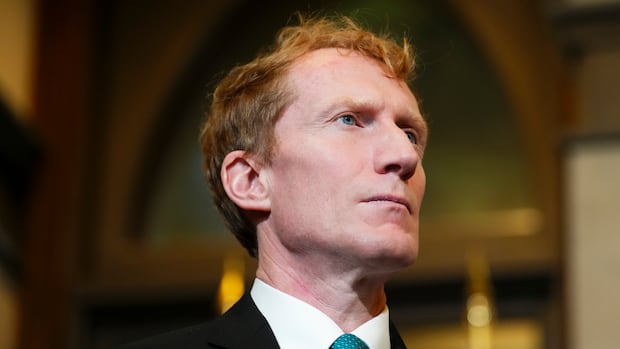
Reducing the number of new admissions to the country could have negative consequences for the economy and pose challenges for commerce, according to business advocates and economists alike.
Economic measures such as the gross domestic product (GDP) have been moving in a positive direction, economists say, in part because Canada’s population has continued to increase due to rising immigration levels.
Statistics Canada reported in March that the country’s population grew in 2023 by about 1.3 million, and 97.6 per cent of that growth was the result of immigration.
Under a government plan released last November, Canada was expected to admit about 500,000 people in both 2025 and 2026. But on Thursday, the federal Liberals changed course, announcing the projected number of new permanent residents to Canada will be cut from 485,000 this year to 395,000 in 2025, 380,000 in 2026 and 365,000 in 2027.
The move is designed to lessen pressure on the country’s housing market and stabilize population growth, Immigration Minister Marc Miller said.
Population growth ‘kept the economy afloat’
But some economists note that higher immigration had economic benefits for Canada, and there could be negative consequences from cutting back.
“If it was not for the population growth that we had last year, the Canadian economy would have been in a recession at the end of 2023,” said Charles St-Arnaud, chief economist with credit union group Alberta Central.
With more people coming to Canada, more money is being spent overall, he said — even if each individual has been spending less as they feel the pressures of a more sluggish economy.

“That kept the economy afloat,” St-Arnaud said, although he acknowledged it was clear that immigration numbers in Canada need to be adjusted due to strains on the housing market and other public services.
Rebekah Young, an economist at Scotiabank, said even a small decrease in GDP due to slowing population growth — or a shrinking population — could have a big impact on the economy.
“Maybe we’re talking about shrinking GDP by, you know, a half per cent or three-quarters of a per cent, but you’re still talking about shrinking GDP as opposed to growing GDP,” she said.
Young, who recently co-wrote a report on Canadian immigration days before the federal government’s announcement, compared policies to the fairy tale Goldilocks and the Three Bears.
“It was too hot last year … but what they announced today, if they actually execute it, is going right into the ‘too cold,’ basically flat-lining growth,” she said.
‘It’s going to hurt,’ says business lobby group
Businesses are warning they will feel negative consequences as immigration is pulled back in Canada.
The Canadian Federation of Independent Business (CFIB) has said its members are struggling to find people to hire for vacant positions in many parts of Canada.
“You know, people aren’t lining up for jobs working the night shift at a quick-service restaurant,” said CFIB president Dan Kelly, who called both temporary and permanent immigrants “a godsend to the Canadian economy” and critical to the operation of businesses across the country.

“It’s going to hurt,” he said, adding that both Thursday’s announcement on immigration numbers and recent changes to the temporary foreign worker program represent a “dramatic ramping down.”
Kelly said his organization’s members struggle to hire from the existing labour pool in Canada and feel they are forced to look elsewhere to staff thousands of positions.
But boosting wages is not always an answer, he said, especially for businesses that operate in the food or retail sectors.
“At a certain level, Canadians aren’t willing to pay the price that would be required to jack up wage levels to the degree that that might be necessary.”
In a public statement, the Canadian Chamber of Commerce expressed similar concerns.
“Immigration is a key driver of economic growth and our only source of workforce growth in the near future. It is more imperative than ever in the context of the aging of our population, low fertility rates and current wave of retirements,” wrote Diana Palmerin-Velasco, the senior director of Future of Work at the chamber.
Ottawa’s move could improve negative attitudes: researcher
A researcher who examines Canadian reactions to immigration and immigrants calls the federal decision to roll back numbers a positive one because it could lessen what she says are recent negative attitudes.
“A weakened economy means that Canadians become more nervous about competing for jobs, competing for resources with people coming in,” said Victoria Esses, director of the Network for Economic and Social Trends at Western University in London, Ont.
“Immigration levels and people’s perceptions of those immigration levels are influencing their attitudes,” she said.
Immigration Minister Marc Miller says the government’s new immigration plan should help relieve pressure on the housing market. The federal government is reducing the projected number of new permanent residents from 485,000 this year to 395,000 in 2025.
Esses said she considers it a “myth” that high numbers of new permanent residents in Canada are directly causing unaffordability across the country.
“Why do I think it’s a myth? Because many of the people who become permanent residents in Canada are already temporary residents. So they’re already living here. They’re already housed somewhere,” she said.
However, in an interview with CBC News Network, BMO senior economist Robert Kavcic said a general curb on immigration could change what Canadians see in parts of the housing market.
“The first thing you’re going to see here is a lot of the pressure that we’ve been facing in the Canadian economy starting to get alleviated … specifically pressure on rents, because a lot of the non-permanent residents flow directly into the rental market,” he said.
Bank of Canada rate decisions could be impacted
Changes to immigration could affect the Bank of Canada’s future decisions on interest rates, said St-Arnaud, the chief economist at Alberta Central.
In particular, he said, the central bank was likely not expecting population growth to potentially drop to zero in its recent projections. The new immigration plan will cause a 0.2 per cent population decline over the next two years, according to a government press release.
“That means that potential growth in the economy is also much lower than what they [the Bank of Canada] were expecting,” St-Arnaud said, adding that he believes this could mean the bank will need to cut rates more than expected in the future.
“I think it’s becoming clearer that the Bank of Canada might need to be a bit more aggressive in providing stimulus to the economy to make sure that the economy is robust enough to adapt to that,” he said.
